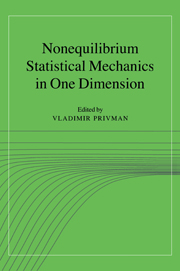Book contents
- Frontmatter
- Contents
- Contributors
- Preface
- Part I Reaction-Diffusion Systems and Models of Catalysis
- Part II Kinetic Ising Models
- Part III Ordering, Coagulation, Phase Separation
- Part IV Random Adsorption and Relaxation Processes
- Part V Fluctuations in Particle and Surface Systems
- Part VI Diffusion and Transport in One Dimension
- 17 Some recent exact solutions of the Fokker-Planck equation
- 18 Random walks, resonance, and ratchets
- 19 One-dimensional interacting random walks in a random environment
- Part VII Experimental Results
- Index
- Abbreviations
19 - One-dimensional interacting random walks in a random environment
Published online by Cambridge University Press: 18 December 2009
- Frontmatter
- Contents
- Contributors
- Preface
- Part I Reaction-Diffusion Systems and Models of Catalysis
- Part II Kinetic Ising Models
- Part III Ordering, Coagulation, Phase Separation
- Part IV Random Adsorption and Relaxation Processes
- Part V Fluctuations in Particle and Surface Systems
- Part VI Diffusion and Transport in One Dimension
- 17 Some recent exact solutions of the Fokker-Planck equation
- 18 Random walks, resonance, and ratchets
- 19 One-dimensional interacting random walks in a random environment
- Part VII Experimental Results
- Index
- Abbreviations
Summary
The dynamics of a grand-canonical ensemble of hard-core particles in a onedimensional (1D) random environment is considered. Two types of randomness are studied: static and dynamic. The equivalence of a grand-canonical ensemble of hard-core particles and a system of noninteracting fermions is used to evaluate the average number of particles per site and the density of creation and annihilation processes. Exact solutions are obtained for Cauchy distributions of the random environment. It is shown that a new physical state is spontaneously created by dynamic randomness.
Introduction
The Brownian motion of a particle in a realistic system may be affected by fluctuations of the environment. One can distinguish these fluctuations according to their time scales. There are fluctuations with time scales large compared to the Brownian motion of the particle. Those are usually considered as impurities and can be described by static randomness. On the other hand, there are also dynamic stochastic processes that occur on time scales equal to or even shorter than the time scale of the Brownian particle. They can be described by dynamic randomness. Mainly for technical reasons it will be assumed that both types of randomness are statistically independent with respect to space and, for the dynamic randomness, also with respect to time.
The purpose of this chapter is to discuss methods for analysis of the dynamics of a 1D ensemble of hard-core particles in a static or dynamic random environment.
- Type
- Chapter
- Information
- Nonequilibrium Statistical Mechanics in One Dimension , pp. 371 - 388Publisher: Cambridge University PressPrint publication year: 1997



